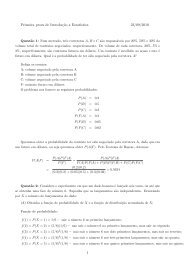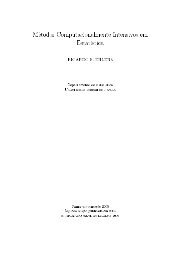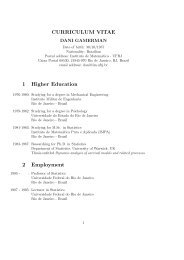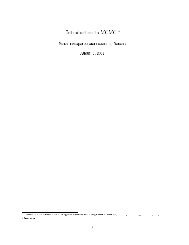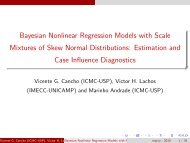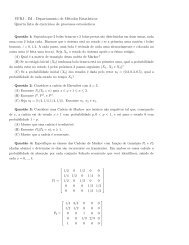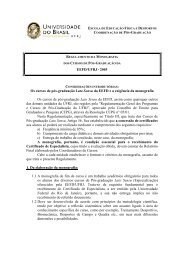Copulas: a Review and Recent Developments (2007)
Copulas: a Review and Recent Developments (2007)
Copulas: a Review and Recent Developments (2007)
Create successful ePaper yourself
Turn your PDF publications into a flip-book with our unique Google optimized e-Paper software.
et al. (2000). To measure contagion they computed the tail dependence function¸U(®). Malevergne <strong>and</strong> Sornette (2002) used extreme value theory to obtain closedform expressions for tail dependence generated by factors models. Stocks possessingminimal empirical tail dependence coe±cient with the market were selected to composeportfolios. They found these portfolios possess superior behavior during stressedtimes. Breymann et al. (2003) analyze in detail high frequency data. They establishthe change in dependence as a function of the sampling frequency, <strong>and</strong> presenta method for deseasonalizing bivariate returns for varying time horizons. Mendes(2005) assessed the extent of integration between stock markets using ¸L <strong>and</strong> ¸U torank twenty one pairs of emerging stock markets returns during stressful periods.The empirical investigation in Mendes (2005) focused on detecting asymmetriesin data. The methodology consisted of ¯tting positively associated copulas to simultaneousexceedances of high thresholds, testing for independence, <strong>and</strong> computingcopula based measures of interdependence <strong>and</strong> contagion. The value of the tail dependencecoe±cients were compared to the Pearson's linear correlation coe±cient<strong>and</strong> its conditional version °(x; y) noted in Section 3.3. An issue not investigatedin Mendes (2005) deserves close attention. It is the assessment of the e®ect of thetime-varying conditional volatility on marginal <strong>and</strong> copula ¯ts, in particular on thedependence measures estimates. As a further development, we provide an illustrationusing emerging stock market indexes. An comprehensive empirical investigation of theextent to which interdependence in emerging markets may be driven by conditionallong range dependence in volatility may be found in Mendes <strong>and</strong> Kolev (2006).Example (assessing the e®ects of FIGARCH volatility on marginal <strong>and</strong>copula ¯ts). Our data consist of 2608 observations of daily stock emerging marketindexes returns from January, 3, 1994 to December, 31, 2003. This period includesexamples of extreme market events such as the Mexican devaluation (end of 1994),the Brady bond crisis (beginning of 1995), the Asian series of devaluation (during1997), the Russian crisis (end of 1998), the Brazilian devaluation (end of 1999), theArgentinian crisis (since 2000). Crises in Latin American <strong>and</strong> East Asian economiesusually result in considerable depreciations of national currencies <strong>and</strong> have importantglobal repercussions.For the illustration that follows we use the indexes representing the stock marketsof Korea <strong>and</strong> Singapore. Korea is the second largest emerging market with atotal market capitalization of US$ 298 billion, <strong>and</strong> Singapore is the ¯fth, with US$148.5 billion. More speci¯cally, the data consists of daily closing levels of the SeoulComposite (Korea) <strong>and</strong> Singapore Straits Industrial (Singapore) indexes.We start by de¯ning thresholds in each margin <strong>and</strong> collecting the joint data abovethethresholds. Totheunivariateexcesseswe¯tageneralizationoftheGPD,themodi¯ed GPD (MGPD). The MGPD distribution function is, for some °;¾ > 0,F (y) =1¡ ¡1µ1+» y° »; if » 6= 0;¾32




